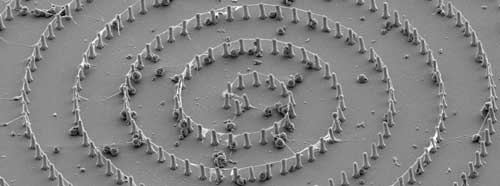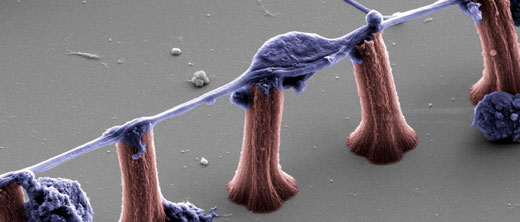| Nov 14, 2019 | |
Carbon nanotubes open new horizons for neuroscience: controlling neural cell outgrowth(Nanowerk News) Carbon nanotubes are extremely tiny cylinders, but at the same time stronger than steel and with exceptional conductive properties. By creating carbon nanotubes pillars with optimal dimensions, the researchers are able to control in which directions neural cells grow, enhancing the formation of complex and oriented neural cell network. |
|
| This impressive result has been recently published in Nano Research ("Carbon nanotube micropillars trigger guided growth of complex human neural stem cells networks"). | |
 |
|
| Ultra-long, guided neurites stretching along a spiral pattern of CNT micropillar templates of several centimetres in total length. (© Springer) | |
| Neurosciences study the structure and function of the nervous system from the cellular and molecular biology to diseases related to nervous system such as Alzheimer’s and spinal cord injuries. Although recognized advances in the studies related to neural disorders and novel strategies for efficient treatment have been made, several challenges still need to be overcome in this field. To enhance the progress in neuroscience, nanotechnology has been playing an important role. | |
| Carbon nanotubes have been studied for over 25 years with significant contributions to the current advances in nanotechnology. The vast majority of the electronic devices such as computers and mobile phones include carbon nanotubes in their components. The most popular use of carbon nanotubes is structural reinforcement as for example, bike frames and tennis rackets. | |
| "My research focus has become very multidisciplinary. As a physicist by background, I have applied material science strategies to study biological systems. During my first postdoctoral studies, I worked two years at the former Department of anatomy and cell biology at University of Oulu. When I started to work with Prof. Krisztian Kordas, I got the opportunity to learn more about carbon nanotubes. I got fascinated by the idea of exploring carbon nanotubes properties towards medicine and started to apply for funding within this topic," says docent Gabriela Lorite Yrjänä, leading research in this project. | |
| "This paper is an outcome of one of my projects named InjectGuide funded by the Academy of Finland. Getting our paper accepted in a respected journal is a sign of recognition without doubts, but my purpose in science is to get this knowledge to help the society, to pay back the investment that we receive from the funding agencies such as Academy of Finland and European Commission." | |
| The ability to control how the neural cells grow opens new perspectives in two important aspects of neuroscience. First one is to create new types of microelectronics arrays to study cell network electrophysiology. The current microelectronics arrays used to understand how neural cells communicate are built in 2D while in human body they grow in a much more complex 3D environment. | |
| The results of this paper demonstrate that carbon nanotubes micropillars can be used as templates to create 3D microelectronics arrays. This work is performed in collaboration with docent Susanna Narkilahti and the postdoctoral researcher Laura Ylä-Outinen from Tampere University, who has the expertise of the electrophysiology measurements and neural cells. | |
| A second potential application of these findings is related to new strategies for treatment of spinal cord or peripheral nerves injuries. The challenge in these types of injuries is to grow neural cells in very specific direction. | |
 |
|
| Growth of macroscopic directed networks of human human neural stem cells on CNT micropillar templates. (© Springer) | |
| "Our results provide evidences that by arranging the carbon nanotubes micropillars at specific spacing, the neural cells outgrowth can be directed in any desired geometry. The drawback of this study towards clinics is the fact that the carbon nanotubes are attached to a rigid surface,"says docent Gabriela Lorite Yrjänä. "Next, we are aiming to transfer this knowledge to complex 3D structures. This work is carryied out together with Professor Minna Kellomäki from Tampere University, who has the expertise in hydrogels for tissue engineering. The collaboration in multidisciplinary research is extremely important to make relevant progress in applied science." | |
| Beyond the field of neuroscience docent Gabriela Lorite Yrjänä and her team are also dedicated to use carbon nanotubes to enable cartilage repair. This topic of research is part of RESTORE project, which receives funding from the European Union’s Horizon 2020 Research and Innovation programme. |
| Source: University of Oulu | |
|
Subscribe to a free copy of one of our daily Nanowerk Newsletter Email Digests with a compilation of all of the day's news. |
